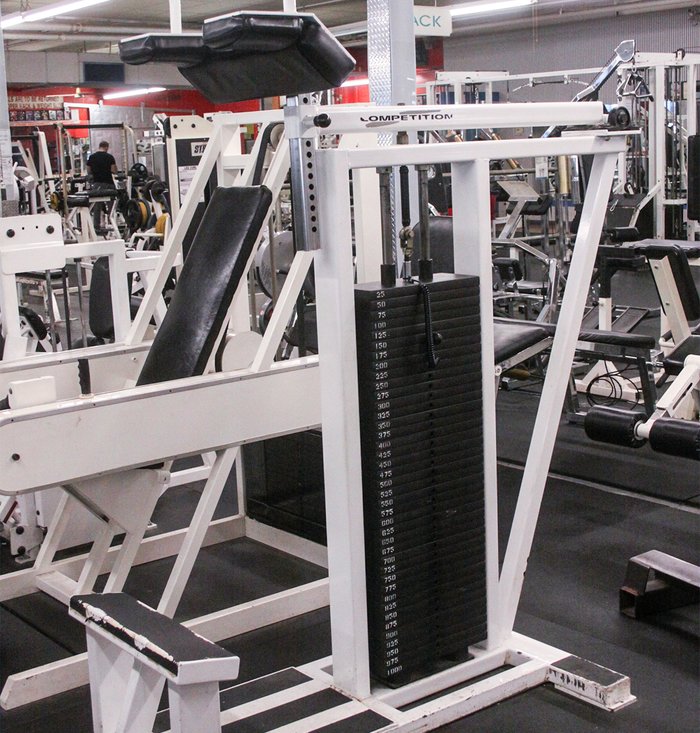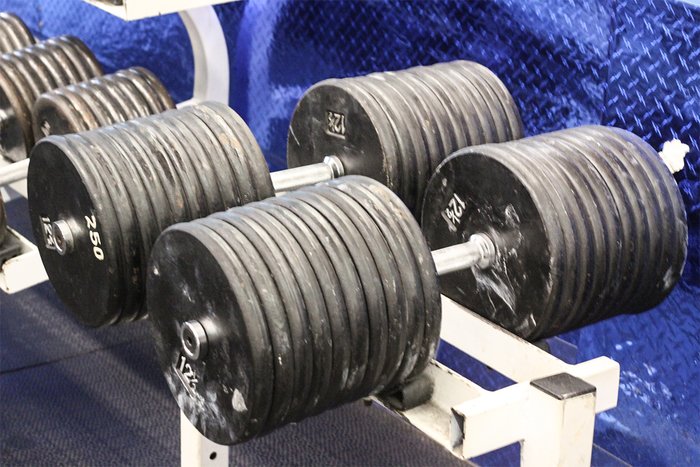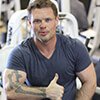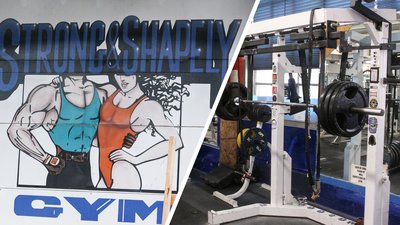If you're a lifting enthusiast, walking into Strong and Shapely Gym in East Rutherford, New Jersey, is like wandering down Main Street in Disney World's Magic Kingdom. In an era of corporate-owned franchised "fitness centers" with identical equipment offerings—none of it interesting—this gym feels like a different species entirely.
Bob Bonham started Strong and Shapely back in 1984 with just $6,000 and a 2,500-square-foot space. Every dime he earned was channeled back into the business, expanding the gym and adding equipment. Today, the gym is 25,000 square feet, and completely packed with equipment. The gym boasts over forty back and forty leg pieces alone! And yet, it never feels crowded; there is plenty of room to move around and among the apparatus, and both hardcore lifters and everyday fitness enthusiasts feel equally at home.
You will find no shortage of unique pieces here. Some of it is vintage, like the 40-year-old Nautilus rear delt machine, or the incline fly machine Rich Gaspari favored in the 1980s. Much is modern, such as the Arsenal glute bridge machine, which saves you the trouble of wrangling a loaded barbell across your hips (a total game-changer).
In terms of loading, there are plenty of plate-loaded machines, alongside a full complement of Kaiser hydraulic pieces and the Life Fitness computerized shoulder press that allows you to program the resistance on the positive and negative portions of the exercise.

There's the custom made, like a custom belt squat machine built for the gym by Brian Grzybowski, and then there's the mind boggling: a standing calf machine with a 1,000-pound selector stack. Flex Lewis is one of the few men who could rep out the entire stack.
But this isn't just a gym full of machines, of course. There are dozens of pieces of cardio equipment—including a Jacob's Ladder—and a fully-stocked powerlifting area replete with monolift and deadlift platform, chains and bands, chalk-bowl stands, and deadlift bar jacks to slide those 100-pound plates in place for the big pulls.
I recently caught up with two long-time Strong and Shapely gym members, powerlifters Erik Bonini and Brent Smith, who gave me an up-close-and-personal tour of seven distinctive pieces that make this gym one of the best places you'll ever get the chance to work out in.
1. 250-Pound Dumbbells
OK, maybe there's nothing unusual about dumbbells, or even heavy dumbbells. But 250-pound dumbbells? Bonham had these commissioned back in the 2000s for Ronnie Coleman to use when he'd visit the gym, and you'd better believe Ronnie would use them!

One dumbbell has "Ronnie" written on it, the other "Coleman." You can't see this because the writing is facing the mirrored wall, and turning the dumbbell around is a challenge you're probably not up for, so just take my word for it. And in good conscience I couldn't ask Brent to try anything with these.
The last time these monstrosities saw use was when powerlifter and bodybuilder Larry Wheels dropped the pair after incline pressing them once. To repeat: that was an incline press. The dumbbells broke and had to be put back together again.
The next best thing, if your gym doesn't have it: Whatever heavy dumbbells it does have! And if you can't press them, so what? Aim to goblet squat them, deadlift them, farmer's carry them—whatever you can!
2. Iron Cross Machine
This is a 30-year-old machine that targets the upper back. Labelling it uncommon is an understatement. The Iron Cross mimics the feeling you get when you hit a back double biceps pose and really squeeze the upper and mid back together. It's one of those "this feels like nothing I have ever tried, but I love it" kinds of machines that only seem to exist in old gyms like Strong and Shapely, and that keeps the clients coming back for decades.
The next best thing, if your gym doesn't have it: Probably face pulls, using either a cable, bands, or a no-hands band set-up.
3. Swing Squat
Custom built by Randy Coil decades ago for the gym, this piece has since gone into mass production and inspired plenty of similar machines in other gyms. Plenty of people at Strong and Shapely look at it suspiciously at first, but once they try it, they're hooked. Believe it or not, this is a popular machine!
Why? Because the Swing Squat takes the pressure off both your knees and lower back when you're performing deep squats, and places the stress on the quads, hams, and glutes. It's a bit like a leg press, but squattier and more comfortable, and you can go surprisingly heavy and deep once you master the set-up.
The next best thing, if your gym doesn't have it: Leg press or hack squat machines may look similar, but most still load the spine pretty heavily. Belt squats are all the rage right now, and they're probably the closest you can get to this machine. Just clip a cable to a dip belt, or hang a dumbbell or kettlebell from the belt. Need more range of motion? Stand on some plates. And if balance is an issue, feel free to hold onto a rack.
4. Chest Supported Free-Weight Row
OK, maybe this isn't the most unusual piece you could imagine. But it is a piece of equipment you don't see around much anymore in the corporate chains, and if your gym does happen to have it, consider this your push to use the damn thing!
Imagine not having to worry about your balance when you're performing bent-over rows, and
you'll understand its significance. Experienced lifters definitely do.
The next best thing, if your gym doesn't have it: Chest-supported rows performed face-down on an incline bench are a great exercise. So is a cable row using two handles performed in the same position.
5. Pull-Over Bench
At first glance you might think you should be doing triceps dumbbell presses on this—and you certainly can—but it's really designed for pull-overs, an exercise that was a favorite of bodybuilding icon Arnold Schwarzenegger and plenty of other old-school lifters, but that has fallen by the wayside.
Arnold and the old-schoolers knew nothing beats alternating sets of high-rep squats (think 20 reps) with an equivalent amount of pull-overs.
The next best thing, if your gym doesn't have it: The best substitute for a pull-over bench is a timeless subject of debate in the weight room. Dumbbell pull-overs on a bench are a solid contender. So are straight-arm pull-downs, face-down pull-downs on a cable row machine, and plenty of others. Try them all, and invent your own answer.
6. Spider Curl Machine
Another vintage classic from the 1970s. Some people attempt to mimic this exercise by leaning over a preacher bench, but this machine was built for this specific type of curl. It allows your arms to hang in space, completely isolating your biceps.
The next best thing, if your gym doesn't have it: Cable spider curls on that bench you just used for rows ought to do the trick!
7. Angled Incline Bench
The angle on this station takes the pressure off your shoulders and places it directly on your upper chest, which is where you should be feeling incline presses. Strong and Shapely also has a version of this for dumbbells with built-on adjustable dumbbell columns so you don't have to kick the dumbbells back into place or have someone else hand them to you.
The next best thing, if your gym doesn't have it: Just do your best with your gym's incline bench and the weights at hand! Good luck finding a version that will hold the dumbbells in place for you, though.
Like old-school lifts and solid programming? Then you owe it to yourself to try True Muscle: 9 Weeks to Elite Fitness with trainer Nick Tumminello. You'll build muscle and hustle with classic movements backed by top-notch contemporary programming!

